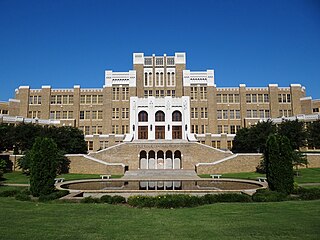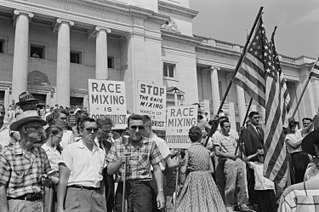
Little Rock Central High School (LRCHS) is an accredited comprehensive public high school in Little Rock, Arkansas, United States. The school was the site of forced desegregation in 1957 after the U.S. Supreme Court ruled that segregation by race in public schools was unconstitutional three years earlier. This was during the period of heightened activism in the civil rights movement.

The Women's Emergency Committee to Open Our Schools (WEC) was an organization formed by a group of socially prominent white women in the city of Little Rock, Arkansas during the Little Rock Crisis in 1958. The organization advocated for the integration of the Little Rock public school system and was a major obstacle to Governor Orval Faubus's efforts to prevent racial integration. The women spoke out in favor of a special election to remove segregationists from the Little Rock school board.

Elizabeth Ann Eckford is one of the Little Rock Nine, a group of African-American students who, in 1957, were the first black students ever to attend classes at the previously all-white Little Rock Central High School in Little Rock, Arkansas. The integration came as a result of the 1954 United States Supreme Court ruling Brown v. Board of Education. Eckford's public ordeal was captured by press photographers on the morning of September 4, 1957, after she was prevented from entering the school by the Arkansas National Guard. A dramatic snapshot by Will Counts of the Arkansas Democrat showed the young girl being followed and threatened by an angry white mob; this and other photos of the day's startling events were circulated around the US and the world by the press.

Daisy Bates was an American civil rights activist, publisher, journalist, and lecturer who played a leading role in the Little Rock Integration Crisis of 1957.

Jefferson Allison Thomas was one of the Little Rock Nine, a group of African-American students who, in 1957, were the first black students ever to attend classes at Little Rock Central High School in Little Rock, Arkansas. In 1999, Thomas and the other students of the Little Rock Nine were awarded the Congressional Gold Medal by President Bill Clinton.

Carlotta Walls LaNier is the youngest of the Little Rock Nine, a group of African-American students who, in 1957, were the first black students ever to attend classes at Little Rock Central High School in Little Rock, Arkansas, United States. She was the first black female to graduate from Central High School. In 1999, LaNier and the rest of the Little Rock Nine were awarded the Congressional Gold Medal by President Bill Clinton. LaNier was inducted into the Colorado Women's Hall of Fame in 2004 and the National Women's Hall of Fame in 2015.

Minnijean Brown-Trickey is an American political figure who was a member of the Little Rock Nine, a group of nine African American teenagers who integrated Little Rock Central High School. The integration followed the Brown v. Board of Education decision which required public schools to be desegregated.
Ronald Norwood Davies was a United States district judge of the United States District Court for the District of North Dakota. He is best known for his role in the Little Rock Integration Crisis in the fall of 1957. Davies ordered the desegregation of the previously all-white Little Rock Central High.

Melba Joy Patillo Beals is an American journalist and educator who was a member of the Little Rock Nine, a group of African-American students who were the first to racially integrate Little Rock Central High School in Little Rock, Arkansas.

Thelma Mothershed-Wair is the eldest member of the Little Rock Nine group who attended Little Rock's Central High School following the 1954 Brown vs. Board of Education court case. The Little Rock Nine was a group of nine African American students enrolled in Little Rock Central High School in 1957. Their enrollment was followed by the Little Rock Crisis, in which the students were initially prevented from entering the racially segregated school by Orval Faubus, the Governor of Arkansas. They then attended after the intervention of President Dwight D. Eisenhower.
Lucius Christopher Bates was an African-American civil rights activist and the husband of Daisy Bates.
Cooper v. Aaron, 358 U.S. 1 (1958), was a landmark decision of the Supreme Court of the United States, which denied the school board of Little Rock, Arkansas the right to delay racial desegregation for 30 months. On September 12, 1958, the Warren Court handed down a per curiam decision which held that the states are bound by the Court's decisions and must enforce them even if the states disagree with them, which asserted judicial supremacy established in Marbury v. Madison (1803). The decision in this case upheld the rulings in Brown v. Board of Education and Brown II which held that the doctrine of separate but equal was unconstitutional.

The Little Rock Nine were a group of nine African American students enrolled in Little Rock Central High School in 1957. Their enrollment was followed by the Little Rock Crisis, in which the students were initially prevented from entering the racially segregated school by Orval Faubus, the Governor of Arkansas. They then attended after the intervention of President Dwight D. Eisenhower.

In the United States, school integration is the process of ending race-based segregation within American public and private schools. Racial segregation in schools existed throughout most of American history and remains an issue in contemporary education. During the Civil Rights Movement school integration became a priority, but since then de facto segregation has again become prevalent.
This is a timeline of the civil rights movement in the United States, a nonviolent mid-20th century freedom movement to gain legal equality and the enforcement of constitutional rights for people of color. The goals of the movement included securing equal protection under the law, ending legally institutionalized racial discrimination, and gaining equal access to public facilities, education reform, fair housing, and the ability to vote.
The Arkansas State Press was an African-American newspaper published from 1941 to 1959. Dubbed "Little Rock's leading African-American newspaper," its owners and editors were Daisy Bates and L. C. Bates. According to historians, the newspaper was "believed by many to be instrumental in bringing about the desegregation of the Little Rock public schools."
Christopher Columbus "C.C." Mercer was an African-American attorney from Arkansas. He was one of the "six pioneers" who integrated the University of Arkansas Law School. As an attorney, he served as an NAACP field representative to advise Daisy Bates, who spearheaded the efforts of the Little Rock Nine who integrated Little Rock Central High School.
Prior to the civil rights movement in South Carolina, African Americans in the state had very few political rights. South Carolina briefly had a majority-black government during the Reconstruction era after the Civil War, but with the 1876 inauguration of Governor Wade Hampton III, a Democrat who supported the disenfranchisement of blacks, African Americans in South Carolina struggled to exercise their rights. Poll taxes, literacy tests, and intimidation kept African Americans from voting, and it was virtually impossible for someone to challenge the Democratic Party, which ran unopposed in most state elections for decades. By 1940, the voter registration provisions written into the 1895 constitution effectively limited African-American voters to 3,000—only 0.8 percent of those of voting age in the state.
The University of Georgia desegregation riot was an incident of mob violence by proponents of racial segregation on January 11, 1961. The riot was caused by segregationist's protest over the desegregation of the University of Georgia (UGA) in Athens, Georgia following the enrollment of Hamilton E. Holmes and Charlayne Hunter, two African American students. The two had been admitted to the school several days earlier following a lengthy application process that led to a court order mandating that the university accept them. On January 11, several days after the two had registered, a group of approximately 1,000 people conducted a riot outside of Hunter's dormitory. In the aftermath, Holmes and Hunter were suspended by the university's dean, though this suspension was later overturned by a court order. Several rioters were arrested, with several students placed on disciplinary probation, but no one was charged with inciting the riot. In an investigation conducted by the Federal Bureau of Investigation, it was revealed that some of the riot organizers were in contact with elected state officials who approved of the riot and assured them of immunity for conducting the riot.

African Americans have played an essential role in the history of Arkansas, but their role has often been marginalized as they confronted a society and polity controlled by white supremacists. During the slavery era to 1865, they were considered property and were subjected to the harsh conditions of forced labor. After the Civil War and the passage of the 13th, 14th, and 15th Reconstuction Amendments to the U.S. Constitution, African Americans gained their freedom and the right to vote. However, the rise of Jim Crow laws in the 1890s and early 1900s led to a period of segregation and discrimination that lasted into the 1960s. Most were farmers, working their own property or poor sharecroppers on white-owned land, or very poor day laborers. By World War I, there was steady emigration from farms to nearby cities such as Little Rock and Memphis, as well as to St. Louis and Chicago.














